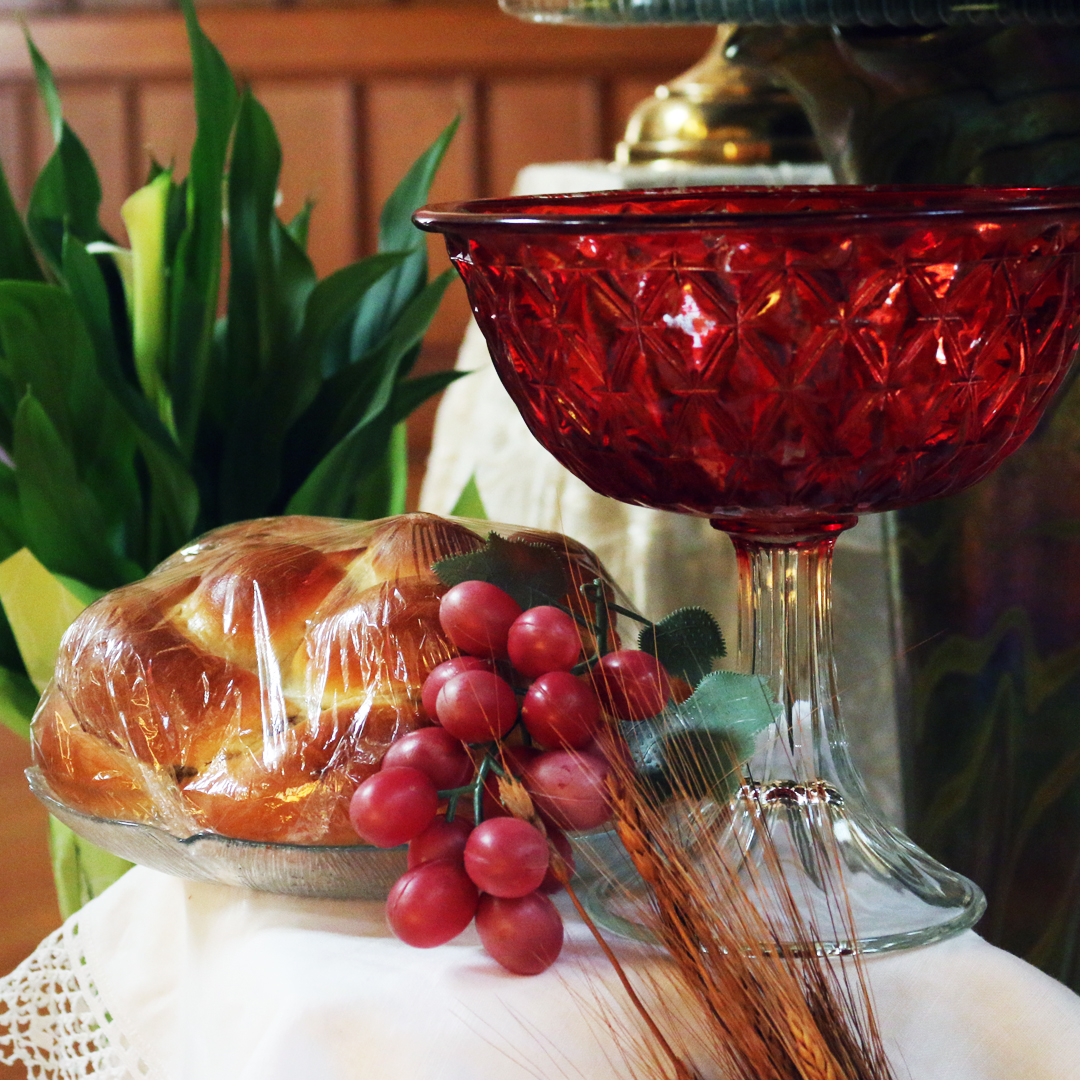A Response to the Coronavirus
It’s something that we like to think of as only happening in the history books, that with all our advancements in technology and medicine, it certainly can’t happen to us here and now - that a disease could sweep through a community and cause such serious illness, death, isolation, economic loss and fear. But as we hear the reports about the spread of the coronavirus and feel its devastating effects in big and small ways, we are once again reminded how fragile we are.
It’s something that we like to think of as only happening in the history books, that with all our advancements in technology and medicine, it certainly can’t happen to us here and now - that a disease could sweep through a community and cause such serious illness, death, isolation, economic loss and fear. But as we hear the reports about the spread of the coronavirus and feel its devastating effects in big and small ways, we are once again reminded how fragile we are.
Our community was first made aware of the virus through some of our sisters who have family in Vietnam and reported that the streets were deserted during the Asian New Year - people dashed out only when absolutely necessary, donning masks as they went, and then hurried home again. Then we learned through our friars that travels to and from Europe were being postponed or canceled. News and prayer requests came in as family and friends located around the country and the world were being affected in various ways - sickness, isolation, economic hardships due to disruption or loss of business, and fear of the unknown.
It is at times like this that a cloistered nun is impelled to more closely unite herself to her Divine Spouse and, like Queen Esther, intercede more ardently for the life of her people.
Some may mistakenly believe that we are isolated from all the suffering of the world, locked inside the security of cloister walls. But as Queen Esther realized, being inside a palace does not guarantee safety from affliction and distress - rather, it places us in a more unique position to intercede for the needs of others. We are deeply aware of our blessings - to continue to have the gift of daily Mass and reception of the Eucharist, to spend time in prayer and adoration before our Eucharistic Lord - these and many other graces are gifts people around the world deeply long for and cannot receive at this time, or even worse, they do not realize the infinite treasure of these things and so do not desire them.
And so, as cloistered nuns, we feel more keenly the isolation, the fear, the suffering of all, and we carry these sufferings in our heart before our Lord in prayer…
…especially during the liturgy, our reception of the Eucharist, and our time of adoration before the Blessed Sacrament. We remember the sick and those most vulnerable - our young and our elderly. We remember those who care for them. We beg protection for chaplains and ministers who reach out with God’s mercy to those most in need. We also intercede for medical personnel, first responders and for their families. We ask for knowledge and wisdom on behalf of medical researchers and developers and our civil leaders. We lift up in compassion those experiencing loneliness, hardships and temptations to frustration, anxiety and fear as schools and businesses close, people are compelled to remain homebound, or are stranded away from home and loved ones as travel and movement are increasingly restricted. And we remember the souls of the departed that they might be granted eternal rest and their loved ones will be consoled.
In faith, we know that our remembrance and our prayers have powerful effects across the body of Christ - when one member suffers, all suffer, and when one member rejoices, all rejoice. Our contemplative life is wholly apostolic in that we implore God’s grace on behalf of all people. For when the hands and feet of Christ - that is, his priests, apostolic religious and laity - are shackled from service, cloistered communities, as the heart of Christ, burn more ardently with His love. And this love and grace knows no boundaries of space or time - it reaches through walls, across continents, and can pierce and warm the hearts of those most in need of consolation and mercy. This is why the contemplative life is considered the heart of the Church and its most noble part.
Saint Rocco, patron against the plague and epidemics, is pictured here with a plague sore on his leg, the angel who brought him healing and a promise from God, and the dog who brought him food every day while he was ill.
As news of the gravity of this disease and its spread reached us, one of our sisters shared with the community a saint and a prayer that her mother taught her to pray against epidemics. St. Rocco has long been venerated in the Church as the protector against the plague and all contagious diseases. Coming from a life of privilege, he forsook all to become a pilgrim. During his travels, he came in contact with a community ravaged by the plague and when no one else would serve the sick for fear of catching the deadly disease, he took up the burden. Eventually he too fell ill with the plague and went into the woods to die a hermit. But the dog of a nobleman brought him food everyday and eventually the nobleman, wondering where his dog was going, followed him and discovered Rocco. He brought him out of the woods, gave him proper lodging and Rocco miraculously recovered. His story continues, but because of his selfless mercy and miracles attributed to him, particularly after his death, he is considered a powerful intercessor against epidemic diseases. We share the prayer with you below that our sister shared with us. May our Blessed Mother and Saint Rocco intercede for us. Lord, have mercy on your people us.
Prayer to Saint Rocco
O Lord, you promised that those who run to Saint Rocco and implore his intercessions will be delivered from all epidemics, and you sent an angel to write this promise on a scroll and give it to him. We beg you to preserve our bodies from contagious diseases and our souls from the contagion of sin, by the merits and intercessions of Saint Rocco. Amen.
UPDATE:
EFFECTIVE MARCH 17, 2020:
Due to the “Shelter-in-Place” Order
issued by the Health Officer of San Mateo County
on March 16, 2020, our chapel is currently closed to the public.
During this time of social distancing, we encourage you to keep up your spiritual life by “attending” Mass online (such as the daily Mass being offered by Bishop Barron), reading and meditating on Scripture (daily readings available in print and audio at the USCCB website), making frequent spiritual communions, praying the Rosary and the Divine Mercy chaplet and prayers, and taking advantage of other online and app faith resources - a wonderful list of linked resources may be found online at the Western Dominican Province’s website.
Please know our community is especially keeping you in our hearts and prayers before the Blessed Sacrament during this time.
Ashes, Dust and Love
Penance. Suffering. Ashes and dust. It’s that time of liturgical year again. So what is the season about? Is it merely to inflict pain and punishment, to make us feel bad about ourselves and our sins? To bring gloom and doom down on us as we are reminded “you are dust, and to dust you shall return”? Certainly if we were a people without faith in a God of mercy and love, without hope for life with Him in heaven, then Lent would indeed be very dark. But we are ultimately an Easter people…
Penance. Suffering. Ashes and dust. It’s that time of liturgical year again. It’s Ash Wednesday. The beginning of Lent. Many of us have a love/hate relationship with this penitential season. We enter into with different levels of commitment. Some of us get pretty creative in our fast and penitential practices to ease into it and slide through. After all, it is innate in us to avoid suffering and seek pleasure. Yet, there is something about the season of Lent that speaks to us on a deeper, more profound level. We NEED it, even if we aren’t sure exactly what to do or how to go about getting the most spiritually out of the season. So, often it stretches before us, six weeks of purple.
So what is the season of Lent about? Is it merely to inflict pain and punishment, to make us feel bad about ourselves and our sins? To bring gloom and doom down on us as we are reminded “you are dust, and to dust you shall return”? Certainly if we were a people without faith in a God of mercy and love, without hope for life with Him in heaven, then Lent would indeed be very dark. But we are ultimately an Easter people, a people of joy and hope and love. Nonetheless, to fully live Easter, we must walk through the passion and death of Christ Jesus, precisely because of sin.
In the creation of Adam and Eve, God made man unique. While we have bodies like the animals, we also have a reason and a will – we are rational creatures. And God gave humans a gift – so long as the mind of man remembered who He was (a creation of God) and remained obedient to Him, then the lower powers of man (his bodily senses and passions) would remain subject to his will and death would be foreign to us. But when Adam and Eve saw the forbidden fruit was good for food, pleasing to the eye, and desirable for wisdom, then took the fruit and ate it, they grabbed at God’s place – they rebelled against the order of creation. Now the carnal appetite of humankind rebels against the spirit and death is the result. Our reason is darkened, our bodies and passions often seek to assert themselves against what we otherwise would will. The forbidden fruit seemed good as food – now we are prone to sins of the flesh (gluttony, lust, sloth). The forbidden fruit was pleasing to the eye – now we are prey to lust of the eyes (greed and envy). And the forbidden fruit was desirable for wisdom – now we puff ourselves up with pride and vainglory and seek to dominate others through wrath.
Fast forward to Jesus. Immediately after Jesus’ baptism, the Holy Spirit drove Him into the desert for forty days and nights – a time of prayer and fasting. It was in the desert that Jesus was tempted by Satan to sin. In His responses to Satan, Jesus shows us how to respond in freedom. Jesus was tempted to turn stones into bread and satisfy His fleshly hunger. He responds, “Man does not live by bread alone.” Jesus was taken to the top of the temple and told to prove He was to Son of God by jumping off – after all, God promised to catch Him (Satan even quotes Scripture in this temptation). But this was a temptation to pride. Jesus answers with humility – “you shall not put the Lord, your God, to the test.” Finally, Jesus was led to a mountaintop and shown the world – it would all be His, if He would just do homage to Satan – a temptation to grab power and possessions, so pleasing to the eye. But at what cost? Jesus says, “Get away, Satan! It is written: The Lord, your God, shall you worship and Him alone shall you serve.”
In the practice of prayer, we are reminded that God is “He who is” and we are those who are not. That is to say, as we grow in relationship with God through prayer, we come to see more clearly the truth about God and ourselves. We grow in humility, charity, and all the virtues as He pours His grace out upon us. But we have to open ourselves up to Him and we do this through prayer.
Through the practice of fasting, penance and mortifications, we bring the body and passions back into subjection to our reason and will. Like a spoiled child that has to be disciplined and trained, our senses, carnal desires and passions need to be purified and brought back into right order. Of course, we can only do this with God’s grace. We are also reminded how weak and helpless we are apart from God. We cannot rely on our own strength – though we work and strive as if it all depends on us, we pray for God’s help and abandon ourselves to Him as if it all depends on Him.
Finally, though almsgiving, that is, the corporal and spiritual works of mercy, we become detached from the things of this world and freed from the sins of greed and envy. We stop worrying about what tomorrow will bring because we learn to trust God’s providence, while at the same time growing in charity toward our neighbors.
Lent is not about punishing ourselves. It is not God’s intent that we simply suffer, as if that were the goal in itself. In St. Catherine’s Dialogue, she repeatedly records God telling her that suffering is NOT a proper goal. Prayer, penitential acts and works of mercy are only worth anything at all because they spring from, are rooted in, and lead to love. So if our Lenten practices are not leading us deeper in relationship with God, helping us do good and avoid sin – in a nutshell, aiding us to more perfectly keep the commands to love God and neighbor – then we need to go back, reassess and adjust our practices.
So, how do your practices of prayer, penance and almsgiving help you love God and neighbor? How can we grow in holiness this Lent? How can we better prepare ourselves to welcome Jesus, like a bride greeting her beloved, on Easter morning?
Beautiful Preaching: Fra Angelico, the Arts and Iconography
Fra Angelico was an examplar Dominican preacher - he sought the face of God in contemplation, gave Christ his entire being and became an instrument in His hand to preach the Gospel and draw people to Himself through the beauty of his paintings and frescoes. This too is the way for the nuns of the Order of Preachers. Our community has, from its beginning, had a tradition in the visual and musical arts, which has blossomed through the course of time in various ways: producing vestments and ecclesiastical linens, Gothic calligraphy and illuminating manuscripts, fine artwork, photography and digital design, and most recently iconography.
To preach the Gospel, words are not always necessary. Today we remember a Dominican friar who remains one of the most renowned artists of all times: Blessed John of Fiesole, more popularly known as Fra Angelico. Fra Angelico was known to frequently say, “If you seek to do the work of Christ, you must live with Christ.” Fra Angelico was an examplar Dominican preacher - he sought the face of God in contemplation, gave Christ his entire being and became an instrument in His hand to preach the Gospel and draw people to Himself through the beauty of his paintings and frescoes.
This too is the way for the nuns of the Order of Preachers. And as each individual is given charisms for the building up of the Church, it is not uncommon to find monastic communities have general charisms as well, both for preaching some particular aspect of the Gospel and often to help support the community: some communities excel in gardening and the use of natural resources, some in various crafts and the production of goods, and so on. Our community has, from its beginning, had a tradition in the visual and musical arts, which has blossomed through the course of time in various ways: producing vestments and ecclesiastical linens, Gothic calligraphy and illuminating manuscripts, fine artwork, photography and digital design, and most recently iconography.
Last fall, our community had an extraordinary opportunity to begin learning an ancient form of prayer and preaching: iconography. Several of our younger sisters have had a desire to learn more about iconography (writing icons) and iconology (the study of icons) and, through the workings of Divine Providence and the generous support of benefactors, several sisters in our community spent a week in an intensive icon retreat with iconographer Kristina Sadley of Prophecy Designs Icons and an affiliate instructor for the Prosopon School of Iconology.
“Icon” is Greek for “image” and traditional icon writing is a prayerful discipline of hand, heart, and mind to bring forth the “Gospel in color” – every canonically written icon reveals Christ, and comes from within the iconographer and his/her prayer.
The week began with Mass, confession, and a blessing of our icon boards and our sister iconographers. Once in our “iconography studio”, we began each morning with prayer, giving glory to the Holy Trinity, asking for grace and illumination as we worked and interceding for those who would venerate the icons we were writing. Except for instructions, our time was largely spent in silence.
We quickly learned that everything in iconography has meaning and purpose – every feature, every color, every step in the process. For example, the wood of the board – a symbol of the wood of the cross; the whiteness of the board – purity and light. Our first step was to trace the image of our icon onto the board using carbon paper, then, once traced, we etched into the white gesso layers with a stylus so our lines would not be lost as we began to apply clay, gold and pigments. This parallels our own life when we receive the Gospel – lightly at first, but when we cooperate with God’s grace, He etches His Word into our hearts.
The next step was also profoundly meaningful to many of us – applying the clay bole and the goldleaf for the icon’s halo. The clay bole represents our humanity. The gold represents God’s glory and divinity. To have the gold adhere properly to the clay, the iconographer must get very close to the clay, with goldleaf piece ready in hand, and breathe deeply but gently on the clay to warm it, reminding the iconographer that God breathed life into Adam. After two or three breaths, the gold is quickly applied and pressed gently onto the warmed clay, and the iconographer moves to the next small section of the halo to begin again. Once the gold is applied, the first color is applied to the board – a bright red line is added to encircle the halo – the blood of Christ and the white has now been broken open into color.
So by now you may be asking, “which icons did the sisters write?” Mary? Jesus? A festal scene? You may be surprised (as we were) to learn we had no choice about our first icon – we would all be writing Saint Michael. But then, Kristina explained why: iconography, as prayer, is a battle – it is spiritual warfare in a profound way. And so we begin with Saint Michael, who is prince of heaven and our help in spiritual battles against the devil. Saint Michael reminds us, “who is like God?” He helps us keep right perspective in humility and our eyes Christ. It is also for these reasons that an iconographer does not part with his or her first icon.
Our first icon completed, our new iconographers are making plans to begin writing their second icon, Saint Gabriel. As Saint Michael helps us grow in humility and clear out the sins and blocks in our hearts and lives to God’s grace, Saint Gabriel brings the Good News and helps us fill our souls with God’s goodness, truth, and beauty.
We give thanks to Kristina and our benefactors whose generosity opened the door for us to this ancient method of prayer and visual preaching of the Gospel. May Fra Angelico intercede for all artists and those who use visual means to promote the goodness, truth and beauty of the Gospel. Saint Michael, Saint Gabriel and Fra Angelico, pray for us!
Want to learn more about assisting our arts and iconography studio or other opportunities to support our cloistered Dominican life? Email us or visit our website. Thank you and God bless!
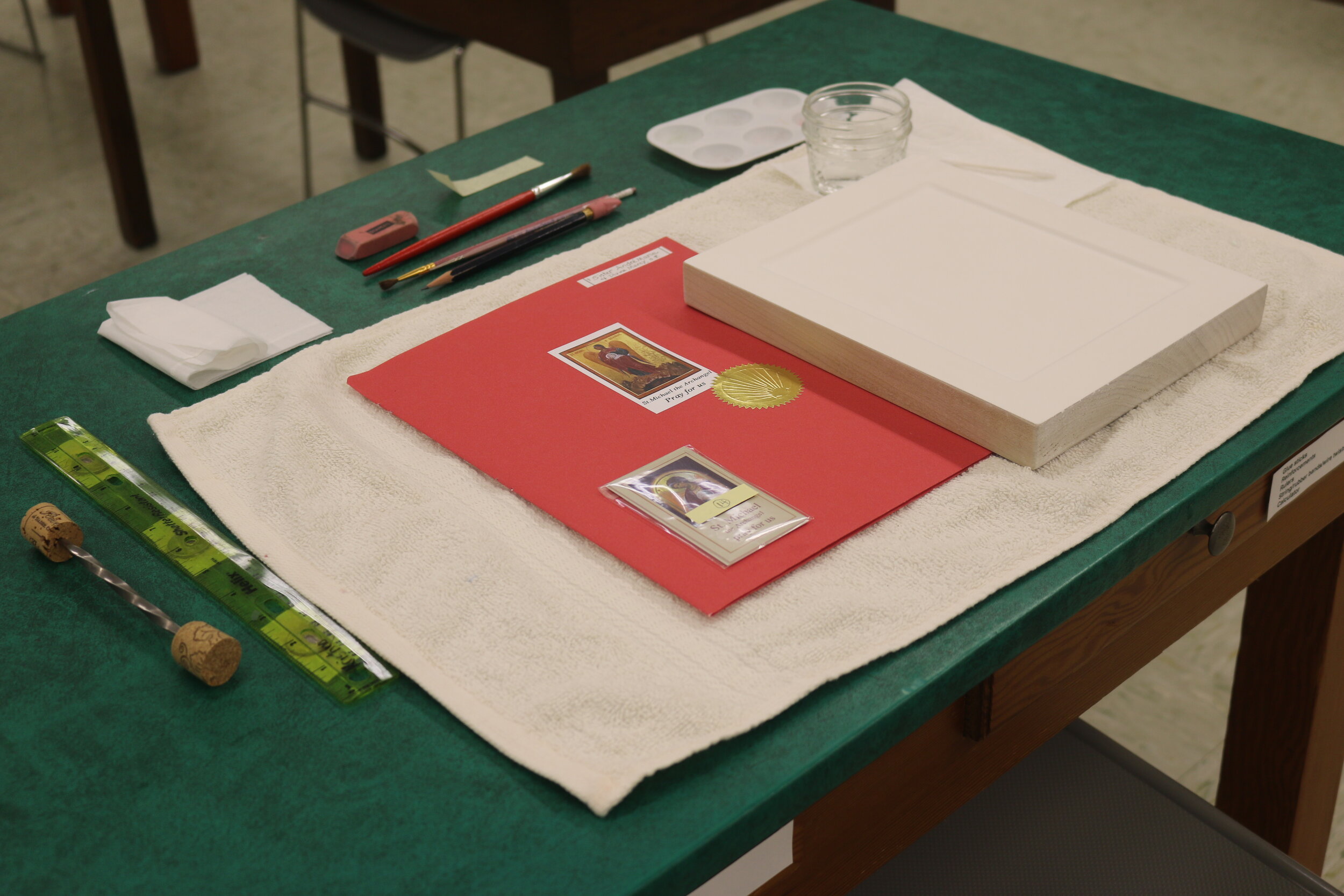
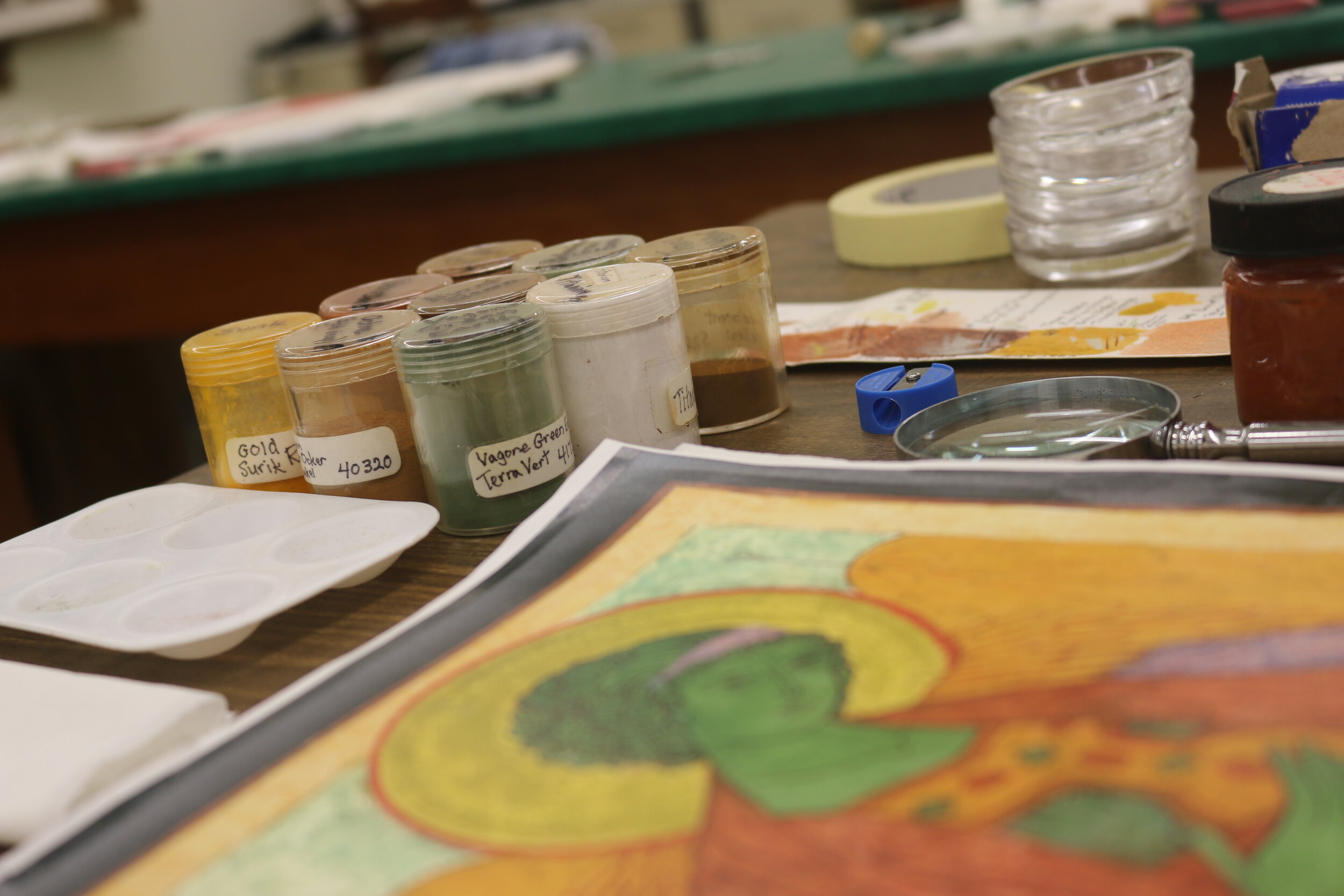
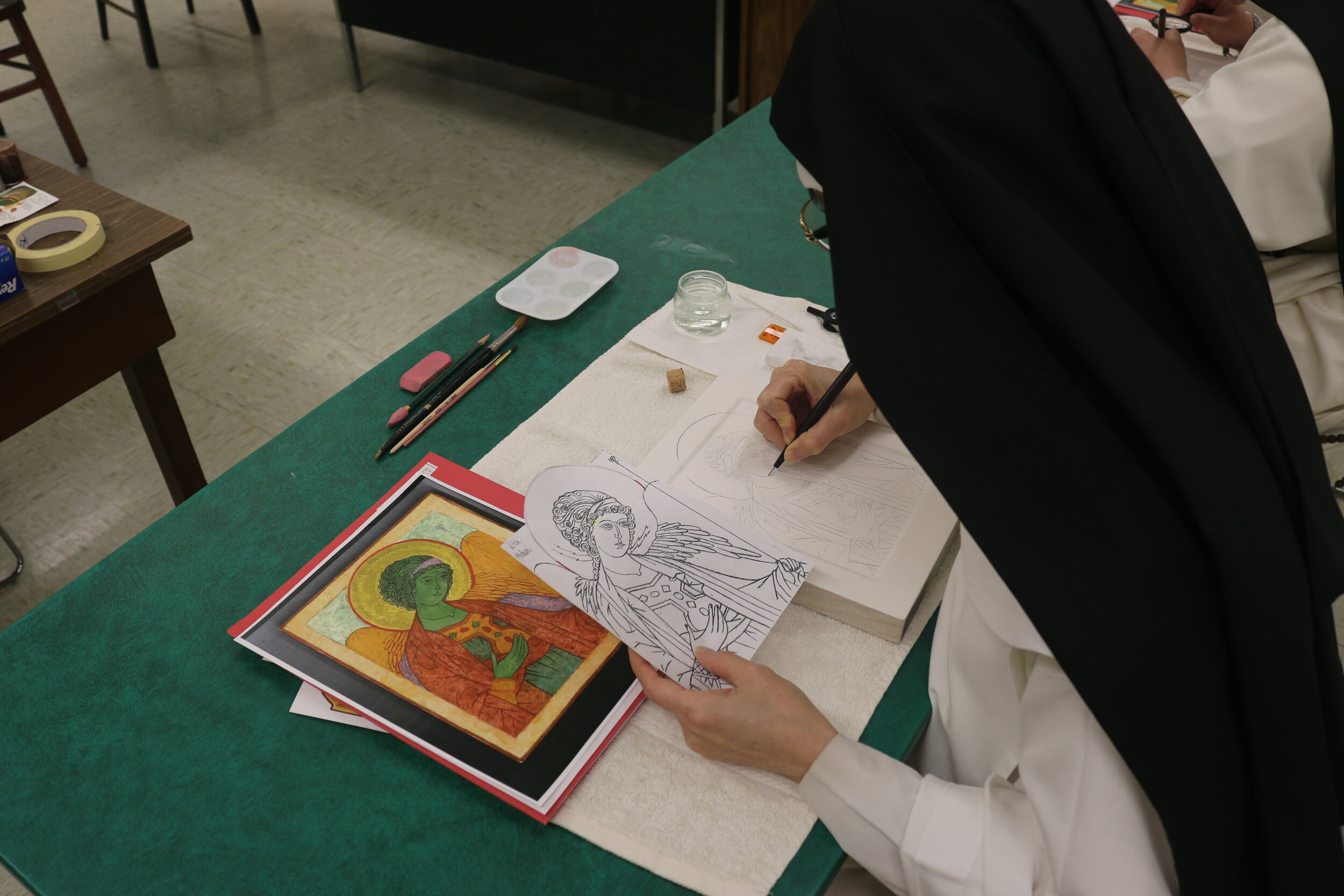
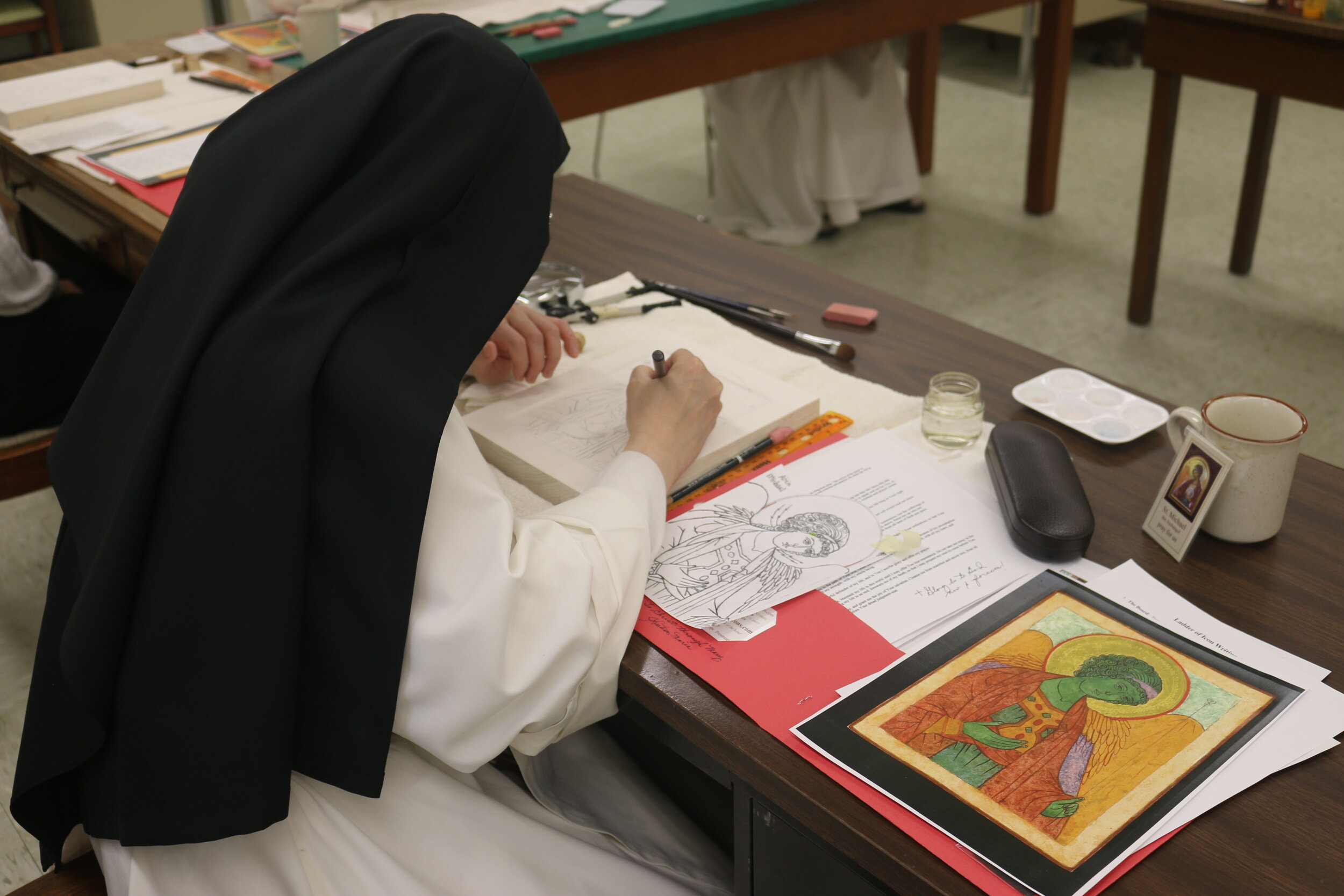
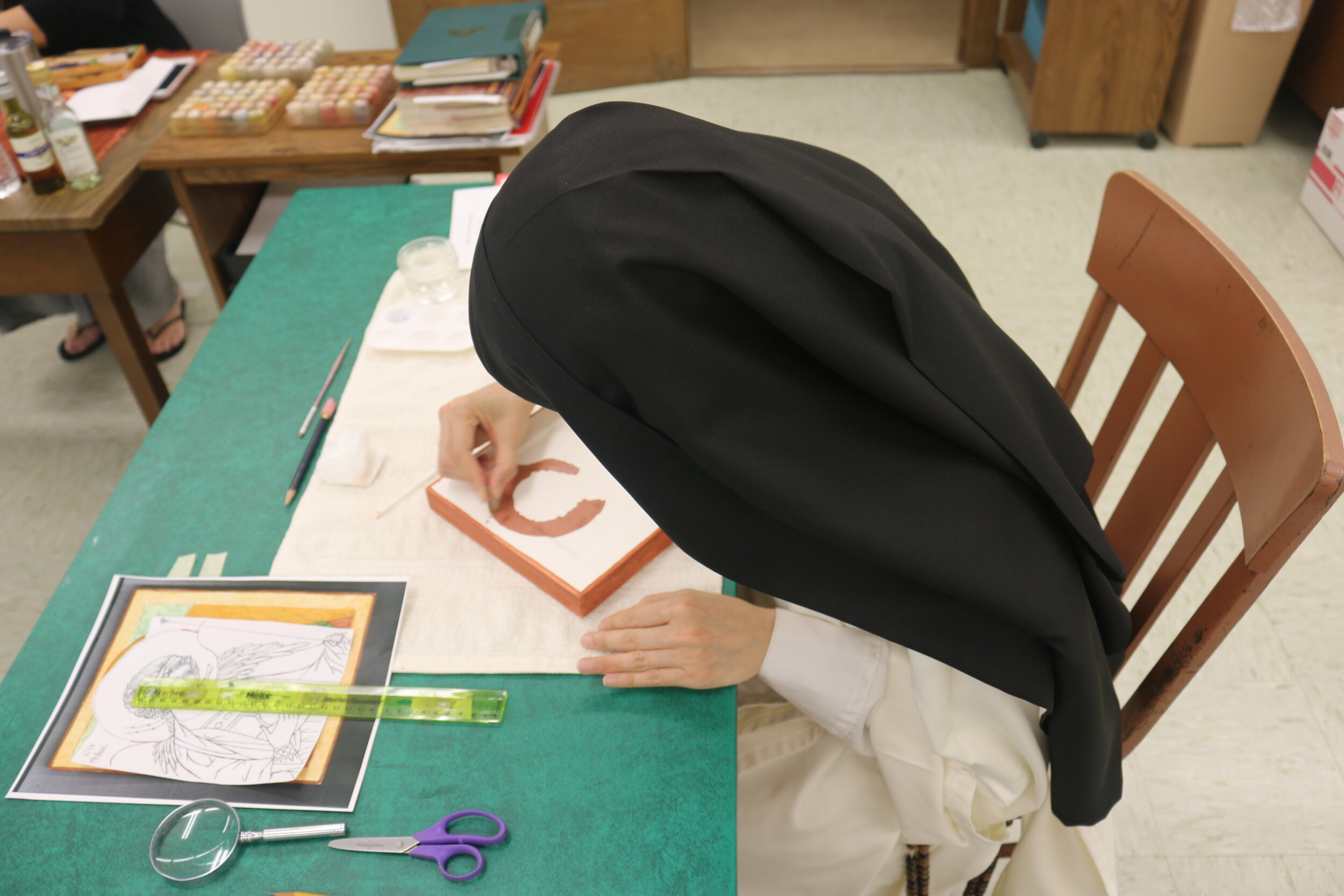
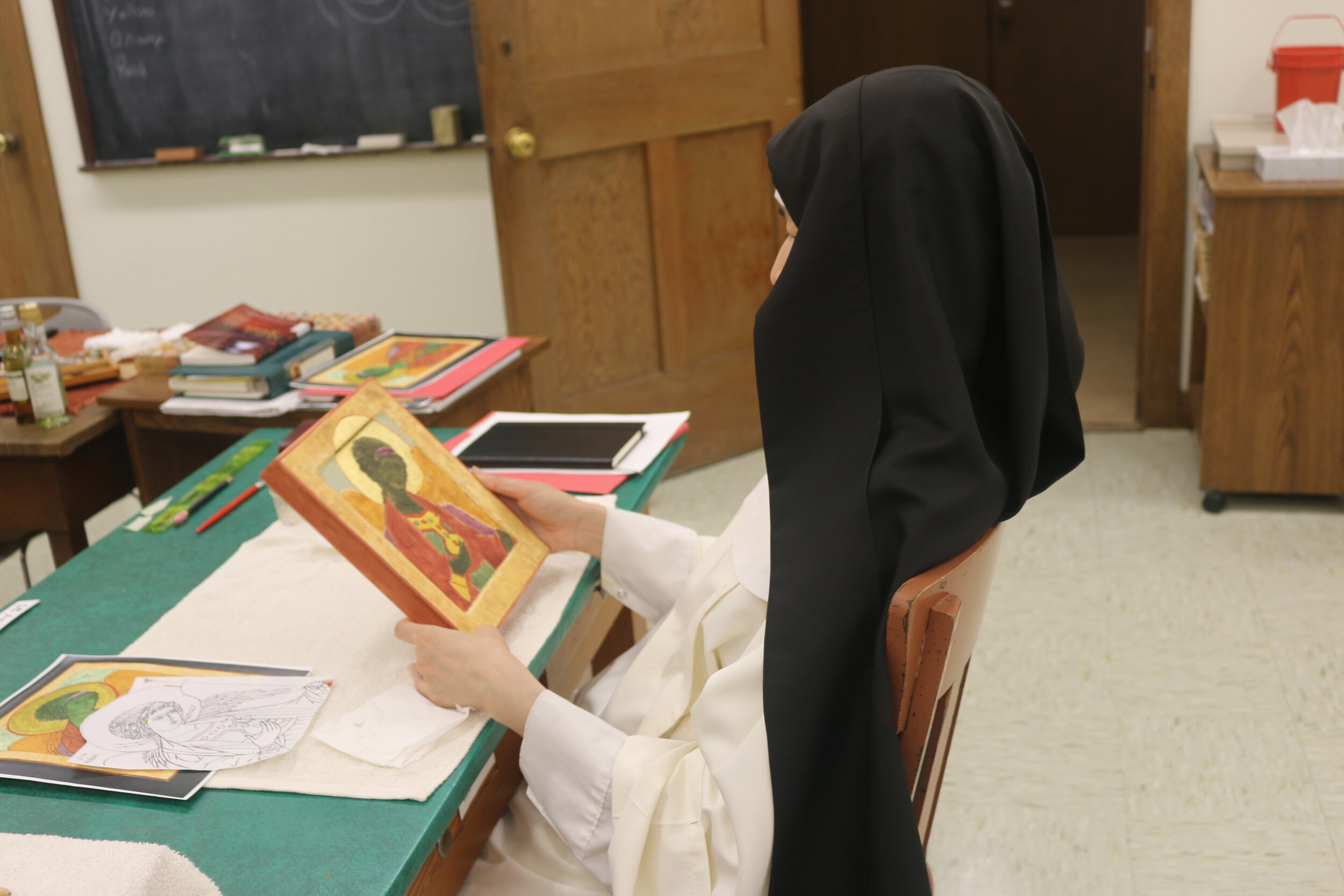

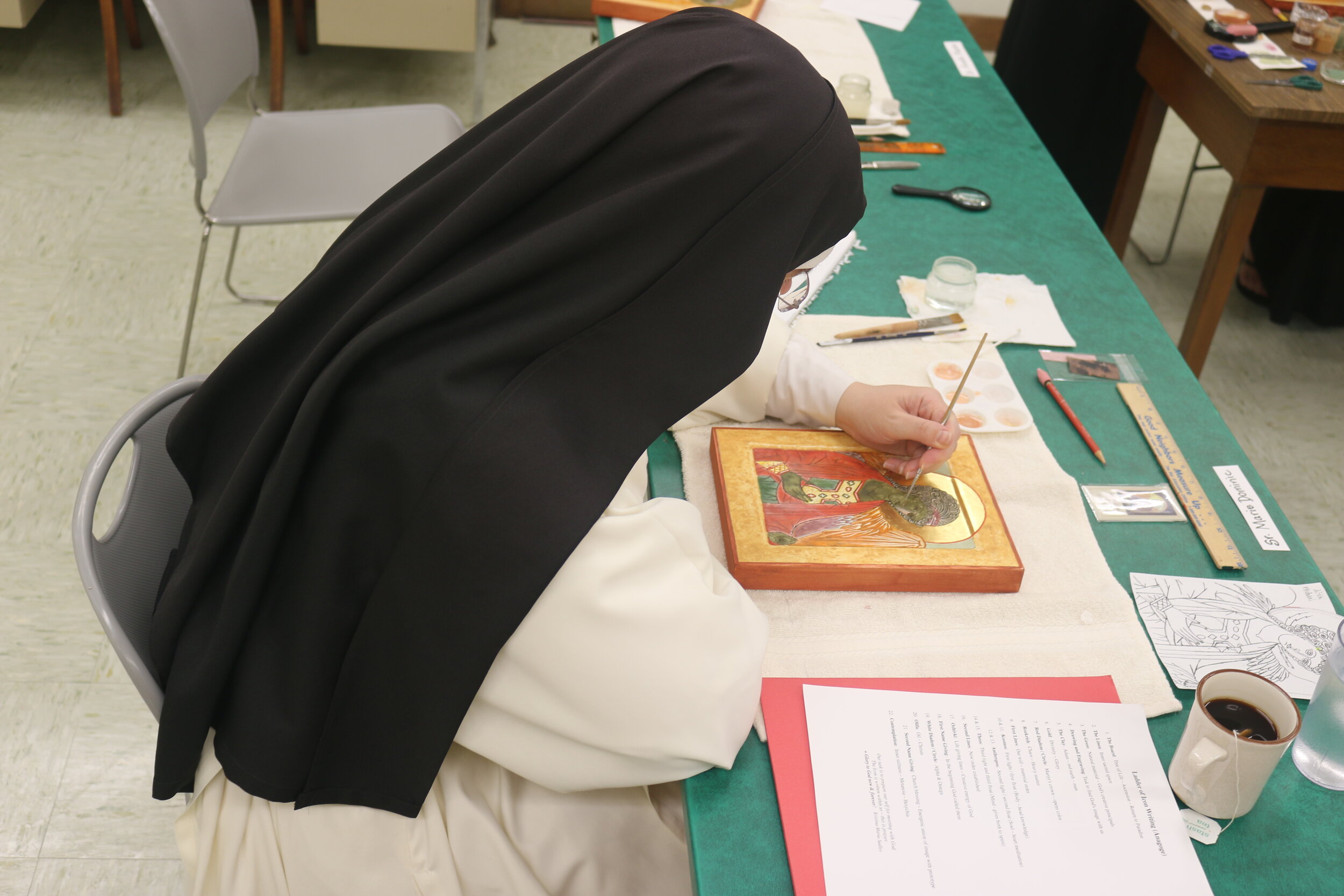

The Encounter Moment
We’ve seen it played out countless times in our imaginations and on-screen: two people going about life as usual, but then, they catch each other’s glance. The world around them fades away as they stop and look at the other. An ordinary moment is made extraordinary by an encounter with the other, and the course of their lives changes. Do this life-changing moment really happen? Can they happen to us? Yes!
We’ve seen it played out countless times in our imaginations and on-screen: two people going about life as usual, but then, they catch each other’s glance. The world around them fades away as they stop and look at the other. An ordinary moment is made extraordinary by an encounter with the other, and the course of their lives changes. Of course, with Hollywood, this is usually a “love-at-first-sight” moment and the skeptics among us scoff that such things actually happen in “real life.” But before we snicker, flip the page or walk away, let’s consider the story of Simeon and Anna in the temple and whether there’s something to such a life-changing encounter moment.
By Fra Angelico - John Pope-Hennessy, Beato Angelico, Scala, Firenze 1981., Public Domain
Simeon and Anna, along with all of Israel, had been waiting, longing, for an encounter with the Messiah. God had brought humankind, and in particular the Jews, through a long, often difficult road of preparing them for the coming of the Messiah. Simeon had even been assured by the Holy Spirit that he would not die before seeing Israel’s savior. And then, the day came. He went to the temple as usual. He saw a young couple enter with a baby boy, a first-born son to be consecrated to God, like every other first-born baby boy. Yet this one was different. Simeon saw and he knew. In this encounter moment, his life was complete and he praised God saying, “Now you may let your servant go in peace, your word has been fulfilled.” Anna, too, came forward in that moment and began prophesying and telling everyone about this little baby boy. One encounter, one moment, changed everything for them.
But surely Simeon and Anna were different; does God really work like that today? Actually, Jesus often comes to us small and quiet, like he did when he was an infant at his presentation in the temple. Think of how many people were in the temple that day, yet Simeon and Anna were the two that were given knowledge of his true identity – that he was the Messiah everyone there was waiting for. If we want to recognize Jesus when he comes to us, like Simeon and Anna, like Mary and Joseph, we must be prepared to receive Him. We must watch with expectation.
On the feast of the Presentation of the Lord (celebrated in the Eastern Churches as “The Meeting”), we processed into the church with lighted candles, “eager to carry [them] in praise of [God’s] name.” We heard the reading from the Old Testament, the promise of the coming of “the Lord whom you seek”, who is like “the refiner’s fire, or like the fuller’s lye”. And we, the people of God respond with the responsorial psalm:
Oh gates, lift high your heads!
Reach up you ancient portals,
that the king of glory may come in!
The verses of the responsorial psalm, part of Psalm 24, was composed for solemn liturgical procession. The psalm describes the attitude of those who would approach the temple. It is a psalm declaring God as king, triumphant over all His enemies. Today, Jesus does not enter a temple made with human hands – we are his temple: he desires to be enthroned in each and every heart, to reveal his triumph over sin and death in each of our lives. We “lift high the gates” when we open wide our hearts and make room for him. The ancient doors of our humanity grow higher when we wait with our candles of faith and hope lighted, burning with the virtues and charity, and we long with expectation for our own encounter with Him, listening for His voice.
After hearing Him in the readings, and offering Him our response of receptivity, he comes. He comes and gives Himself wholly and completely in the Eucharist. He comes, hidden under the appearance of bread and wine, but he is here – body, soul, blood and divinity. To see, we must look with the eyes of faith. To receive, we must lift up our hearts to him in hope and thanksgiving. At this moment, the moment of communion with our God and King, the Church gives us the words of Simeon as our own: “My eyes have seen your salvation, which you prepared in the sight of all the peoples.”
Were we prepared for our encounter moment with him? Perhaps at this moment of life, our cups overflows with goodness, beauty and riches? Let us give thanks to God who has given us these things. Perhaps life is a bit blurry, full of questions or we are uncertain about the future? Then we can stand with Mary in the temple as she hears Simeon foretell that “a sword will pierce her heart”, yet she cannot fully grasp the meaning of those words in that moment; she keeps them in her heart and ponders them as she walks through life by faith. Or perhaps at this moment in our life, we are in the darkness of a Garden of Gethsemane, or even nailed to the cross, experiencing deep pain, abandonment, helplessness. In each of these moments of life, HE COMES.
Let us celebrate the coming of our King and Savior! He has come, he will come again, and he continues to come at this moment, if only we will surrender to Him in trust and open wide to let Him enter. May the Church’s prayer after communion on the Feast of the Presentation of the Lord be our own throughout this week:
By these holy gifts which we have received, O Lord,
bring your grace to perfection within us,
and, as you fulfilled Simeon’s expectation
that he would not see death
until he had been privileged to welcome the Christ,
so may we, going forth to meet the Lord,
obtain the gift of eternal life.
Through Christ our Lord.
War, Peace, and the Rosary
Every morning when a Dominican dons the habit, he or she is reminded of the fact that he or she is in the middle of a war. The habit hasn’t changed much since it was given to Saint Dominic and the first friars and nuns of the Order of Preachers – white tunic and scapular with a belt, black cappa (and veil for the sisters). But conspicuously attached to the belt where a medieval knight would have slung a sword, is a rosary.
Every morning when a Dominican dons the habit, he or she is reminded of the fact that he or she is in the middle of a war. The habit hasn’t changed much since it was given to Saint Dominic and the first friars and nuns of the Order of Preachers – white tunic and scapular with a belt, black cappa (and veil for the sisters). But conspicuously attached to the belt where a medieval knight would have slung a sword is a rosary.
But we should not think that because we have replaced a sword with a rosary that we are exempt from engaging in war and battles. The real war is all around us and the battleground is our hearts and souls, as well as the hearts and souls of all those we hold dear. It is the war between good and evil and the stakes are eternal. We experience this war not only in broadscale violence, oppression and injustices, but even on a seemingly much smaller, yet more insidious scale. Every time we choose sin, every time our heart becomes a bit harder or more insensitive to the things of God, as well as every time we choose the good, helping our neighbor, extending a kind or encouraging word to someone in pain, these are blows for one side and against the other. We can perpetuate the evil in the world, or we can be a beacon for good.
Aleksandr Solzhenitsyn describes our situation this way: “If only it were all so simple! If only there were evil people somewhere insidiously committing evil deeds, and it were necessary only to separate them from the rest of us and destroy them. But the line dividing good and evil cuts through the heart of every human being. And who is willing to destroy a piece of his own heart?”
Today it is so easy to take what we see and hear and think “us versus them”, whether it’s in politics or the Church. And, we can also fall into the trap of assuming “our side has the truth!” Yet if we want true peace, truth and goodness to prevail in the world, it must first prevail in our hearts. We must be transformed by the renewal of our minds and our hearts must be made like Jesus.
Besides the Eucharist and the sacraments, we have no more powerful weapon to wield than Our Lady’s Rosary. Dominicans have long been champions of the rosary: it is an incarnational prayer that incorporates the body, the heart and the mind as the beads slip through fingers and the vocal prayers pass through the lips. It is a Marian prayer as it tames the heart to be docile and receptive to God’s word. It is a Christocentric prayer as the mind is illumined and transformed by Truth contained in the mysteries. It has the power to change lives and bring souls to eternal bliss in God. It can be prayed anywhere at almost any time. In times of grief, we can offer the sorrowful mysteries and join our pain with those of Jesus and Mary. The joyful mysteries show us what should really make us happy, what we should desire and strive for. And the glorious mysteries give us hope and courage to persevere to the end. We have no choice about whether we will be involved in this war. There is no neutral zone.
The Rosary is a powerful weapon in our daily spiritual battle. If we want peace in our world, in our country, in our communities, in our families, in our hearts, we must take up the weapons God has provided for us, stand firm and fight. And the battle begins and ends within each one of us.
Our Lady of the Rosary, pray for us!
May They Rest in Peace: Anniversary of Deceased Friends and Benefactors of the Order of Preachers
Gratitude towards benefactors is a natural virtue, but the grace of Christianity perfects its interior principle and makes its effects more lasting. When our friends, employees and benefactors have passed into eternal life, gratitude follows them beyond the tomb and assists them by numerous prayers.
Gratitude towards benefactors is a natural virtue, but the grace of Christianity perfects its interior principle and makes its effects more lasting. When our friends, employees and benefactors have passed into eternal life, gratitude follows them beyond the tomb and assists them by numerous prayers. Every day before meals the “De Profundis” [Psalm 130] is recited for them, as if we dared not take our bread before recommending to God those to whom, perhaps, we owe it.
Today, we commemorate our departed friends and benefactors by a solemn anniversary. Let each one, therefore, be mindful of it, and thus merit the increased protection of the saints for the work to which we have devoted our life. This devotion was remarkable in the Ven. Sister Magdalene de Lorca who, while visiting the different altars of the convent church (a devotion very dear to St. Dominic), saw the souls of the departed anxiously following her from one altar to another until she had finished her prayers.
Prayer: My God, grant to the faithful departed friends and benefactors of the Order a place of refreshment, light and peace.
Practice: Before meals, say three Ave Marias for the deceased who have done you good, either spiritual or temporal, either in the world or in religion.
From “Saints and Saintly Dominicans: Daily Reflections on Their Lives”, edited by Rev. Thomas a Kempis Reilly, O.P. (1915).
Celebrating Hope: Dominic and the Assumption of Mary
Hope. It’s a word we hear a lot - it even became a campaign slogan - but do we really know what it is? It sounds good and on some level, we instinctively want it, but how can we get it? We can learn a lot about hope by looking to our Blessed Mother and our Holy Father Dominic.
Hope. It’s a word we hear a lot - it even became a campaign slogan - but do we really know what it is? It sounds good and on some level, we instinctively want it, but how can we get it? We can learn a lot about hope by looking to our Blessed Mother and our Holy Father Dominic.
Generally speaking, hope is a desire for a good that is difficult to obtain, with the expectation of eventually obtaining it.
As a supernatural virtue, like faith and charity, it is infused in us as a gift of God and by it we long for God and to spend eternity with Him. Hope motivates us to do acts of virtue, to seek God, to love and serve Him with the expectation that He will do what He has promised and grant us eternal happiness with Him. By supernatural faith, we “see” our ultimate target - God - and it is by hope and charity that we fly and soar to the heights.
We can also think of hope with this analogy: picture a toddler who wants to be picked up. They stand in front of their parent, looking up, reaching as high as they can, standing on tip-toe even. No matter how hard they try, they cannot get themselves in their parent’s arms, but they have the expectation that their parent will look down with kindness and lift them the rest of the way. Hope is that desire and expectation, and yet more. Because without God’s gift of hope, we would never look and reach up in the first place.
Our Blessed Mother’s assumption is a lesson in hope.
By this teaching of the Church - that at the time Mary’s life ended on earth, God granted her the privilege of not having to wait until the end of time for the resurrection of her body, but instead her body and soul were assumed into heaven - the glorious triumph of her Son Jesus over sin and death shines all the more brightly. Mary was granted singular graces not because she earned or deserved them, but solely due to God’s lavish gifts of mercy. She was uniquely chosen to walk in unity with the life and her Son, Jesus. And just as His body did not see the corruption of death, so too was Mary’s body preserved from this.
Mary’s assumption teaches us that our hope does not lie in the things of this world - our bodies and souls are destined to a loftier end: heaven.
Materialism, so prevalent in Western culture today, “threatens to extinguish the light of virtue and ruin the lives of men by exciting discord.”
-Pope Pius XII
Munificentissimus Deus
Many monastics and saints have commented that our world would be much more peaceful if the words “mine” and “yours” ceased to exist. So many of today’s arguments, battles, and wars are over material goods that cannot add one moment to our life on earth, nor increase our true happiness. Some of the richest people in the world are also the most miserable. And that is one reason why our Holy Father Dominic urged his sons and daughters to “make your treasure from voluntary poverty.” Actual poverty frees a person from worldly cares because they have nothing to lug around or protect from damage or thieves. “Voluntary” poverty implies more than actual poverty – it requires a detachment of the heart from material goods, a true poverty of spirit. A person can be poor in fact and yet still chained by the desire to possess what they do not have. By choosing to be poor, a person not only renounces actual possession of goods, but also the desire to possess those goods. It is this detachment of the heart that makes it light enough to fly up to God.
Mary’s assumption reaffirms the dignity and beauty of the whole human person - body and soul.
While our ultimate destiny is not this world, we must also remember that God’s creation is good, including our bodies, because that is how God created. Yet, because of sin, “we groan…awaiting the redemption of our bodies.” Because we still labor under the effects of sin, we must discipline our bodies and emotions to put them in right relationship with our intellect and ultimately God. But we should not abuse our bodies – the human person is both body and soul. Our holy Father Dominic began his preaching mission in earnest when he encountered a heresy that denied the goodness of the created world, including the human body. Dominic preached tirelessly against this heresy and spent himself to help provide for the corporal needs of the poor, even to the point of selling all he had, including his books, to help feed starving people during a famine. Dominic also left us the heritage of his “Nine Ways of Prayer”, descriptions of how he prayed using body postures, gestures and his voice to praise God and intercede for others.
Mary’s assumption should stir our hearts to a stronger piety toward our heavenly Mother, and move us with the desire of sharing in the unity of Jesus Christ's Mystical Body.
That is, it should make us more receptive to God’s gift of hope. Because hope is a supernatural virtue, it is a gift. Yet, there are things we can do to make ourselves more receptive to it and to the extent we have it, we should exercise it. In his letter to the Romans, Saint Paul gives us a good place to start:
Therefore, since we have been justified by faith, we have peace with God through our Lord Jesus Christ, through whom we have gained access [by faith] to this grace in which we stand, and we boast in hope of the glory of God.
Not only that, but we even boast of our afflictions, knowing that affliction produces endurance, and endurance, proven character, and proven character, hope, and hope does not disappoint, because the love of God has been poured out into our hearts through the holy Spirit that has been given to us.
- Romans 5:1-5
From this we see that the road of hope passes through affliction. Our Blessed Mother showed us how to walk in this path as she walked it with her Son, for she endured affliction all the way to the foot of the cross on Calvary. And the saints also light this way for us. When things are darkest, that’s when we should look up all the more and wait for the dawn with desire and expectation - God will keep His promises! As the psalmist sings,
Those who sow in tears
will reap with cries of joy.Those who go forth weeping,
carrying sacks of seed,
Will return with cries of joy,
carrying their bundled sheaves.-Psalm 126:5-6
May we increase our love for her who shows her motherly heart to all the members of this august body. And may our Mother Mary and holy Father Dominic intercede for us!
Eight Ways We Go Astray
On the road to God and eternal happiness, there are eight common pitfalls that can trap us and keep us captive. Here’s what they are and how to avoid them.
From the earliest days of Christianity, men and women have gone out into the desert, seeking God and to “bear fruit worthy of repentance.” These Desert Fathers and Mothers are at the foundations of monastic life, and their wisdom and teachings were passed down from one monk and nun to the next. But one man systematized them into some very practical advice for those seeking God. Evagrius described for us “Eight Evil Thoughts” and stated that all our thoughts can be classified into one of these eight. And these thoughts, if left unchecked, keep us from true prayer, lead us away from God and take us down paths were we “do what we don’t want to do and don’t do what we want.” Evagrius and the Desert Fathers knew that the first step to real transformation is to know ourselves – our own thoughts and desires – and only then can we avoid the insanity of doing the same thing again and again, yet expecting different results.
These Eight Thoughts were picked up, further developed and refined by John Cassian, Saint Gregory the Great, Saint Thomas Aquinas and others to become the Capital (or Deadly) Sins many of us are familiar with today. So here’s a quick rundown of the Evagrius’ “Eight” and how to fight them.
Finally, some general remedies:
Suffer from a wandering mind? Regain focus by reading Scripture and spiritual books, spending time at night or in the early morning in silent waiting on God, and pray.
Ablaze with “flames of desire”? Quench earthly desires with fasting, regular manual labor (and/or exercise), and solitude.
Afflicted with irascibility (anger)? Calm the beast within by singing psalms (for example, the Divine Office), practicing patience, and almsgiving or works of mercy.
Of course, we can’t fight any of these without God’s help and grace, so we should always ask Him for it!
Mary, Our Patroness
Since Jesus told the beloved apostle, “Behold your mother,” at the cross, Christians have gone to Mary, as she is our mother in the order of grace. But Dominicans have a special devotion to Our Lady as she is our Patroness and was instrumental in bringing our Order into existence, sustaining it and causing it to flourish.
Since Jesus told the beloved apostle, “Behold your mother,” at the cross, Christians have gone to Mary, as she is our mother in the order of grace. But Dominicans have a special devotion to Our Lady as she is our Patroness. Blessed Humbert of Romans declared that “the Blessed Virgin was of great help in the beginning of the Order…and it is to be hoped that she will bring it to a good end.” (Opera II< 70-71). From the very beginning of the Order, stories abound of how Mary helped bring our Order into existence and of her continual care and protection of its members. Here is one such story as told by one of the first nuns of the Order, Blessed Cecilia.
How the Blessed Virgin Appeared to [Saint Dominic] in Prayer and Revealed her Protection Over the Order
One night, after prolonging his prayers until midnight, he left the church and came to the dormitory, where he completed what he had come to do and, taking his place at one end of the dormitory, continued to pray. As he stood praying, he glanced at the other end of the dormitory and saw three beautiful women enter, but noticed that the one in the middle was a venerable lady far more beautiful and dignified than the other two. One of them was carrying a beautiful, shining vessel and the other an aspersorium which she handed to the lady in the center, who went from bed to bed sprinkling the brethren with holy water and blessing them.
The lady said to Blessed Dominic: “I am the one you call upon in the evening. When you say, ‘Turn therefore most gracious advocate thine eyes of mercy toward us,’ I prostrate myself before my Son and ask him to preserve this Order.” After this she continued to sprinkle and bless all the others and then disappeared.
When she was gone Blessed Dominic returned to pray in the place he stood before. Suddenly, he was rapt in spirit before God and saw Our Lord and the Blessed Virgin sitting at His right. It seemed to Blessed Dominic that Our Lady was wearing a cape of bright blue, the color of sapphire. As Blessed Dominic looked around, he could see religious of all the orders but his own around the throne of God, so that he began to weep bitterly and stood far away, not daring to approach the Lord and His mother.
Then Our Lady motioned for him to come near. But he would not dare, until Our Lord Himself also called him. Then Blessed Dominic cast himself before them weeping bitterly. But Our Lord told him to rise, and when he did, Our Lord asked him, “Why are you weeping so?” “I am weeping because I see all the other orders here but no sign of my own.” And the Lord said to him, “Do you want to see your Order?” And he answered, “Yes, Lord.”
Then Our Lord, putting his hand upon the shoulder of the Blessed Virgin, said to Blessed Dominic, “I have entrusted your Order to my Mother.” Then he asked him again, “Do you still wish to see your Order?” And against he answered, “Yes, Lord.” Then the Blessed Virgin opened the cape which covered her and spread it out before Blessed Dominic, to whom it seemed vast enough to cover the entire heaven and, under it, he saw a large multitude of the brethren. Then, prostrating himself, Blessed Dominic gave thanks to God and to Blessed Mary His Mother.
Detail from an altar card illuminated by the Dominican nuns of our monastery.
Go to Joseph!
This is the advice given by many saints, and Dominicans are no exception.
This is the advice given by many saints, and Dominicans are no exception. The Dominicans began invoking Saint Joseph in the Litany of the Saints before he was added to the Litany according to the Roman. The sixty-third Master of the Order, Father Jandel, often recommended to the friars devotion to Saint Joseph.
Saint Joseph assists the young Dominican novice to imitate the simplicity and docility of the Infant Jesus. For those who are devoted to the Holy Rosary, he obtains knowledge and love of the mysteries of Mary. Those engaged in work, labor with more courage under the eye and by the example of Saint Joseph. Those engaged in study can better sanctify in his sweet company the hours spent; the apostle, called to go into the world, carries there the same blessings which the Holy Family, with Saint Joseph for guide, carried into Egypt. The dying sanctify under this holy patronage their last hours, and obtain a more peaceful end and after death received more abundant prayers.
It was in order to obtain these more fervent suffrages that the holy brother Joseph de Rueda every night when the bell rang for the prayers for the dead, went and sprinkled the graves with holy water, and then the cells of the prior and the brethren, in the hope that all would recite more devoutly the prayers for the dead. And in our community, one of our devotions to Saint Joseph is to pray his memorare each evening after Supper.
Saint Joseph, pray for us!
Based on an excerpt from Saints and Saintly Dominicans, edited by Rev. Thomas a Kempis Reilly, O.P. (John Murphy Company, 1915).
















